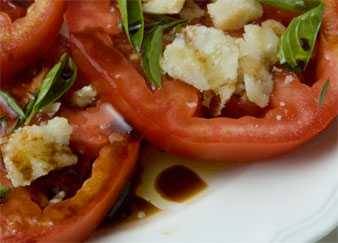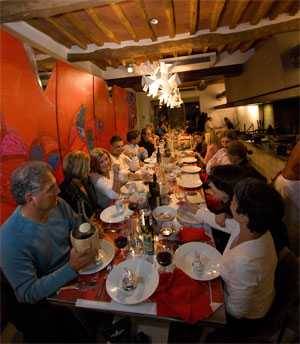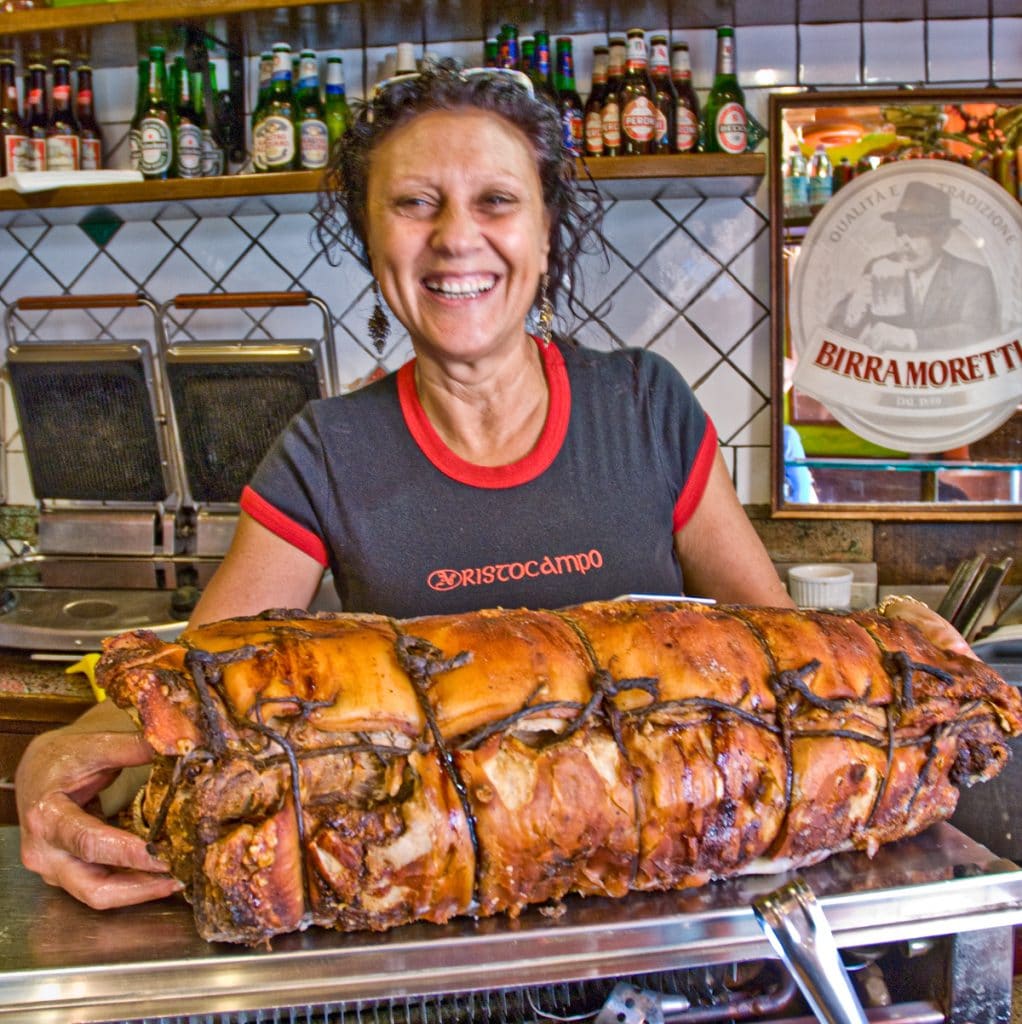A shorter version of this article is scheduled to run in the January 2009 issue of Restaurant Hospitality magazine, a magazine for restaurant management.
I have just returned from two weeks in northern Italy. Since Italian culinary concepts have touched practically every cook in North America, I looked for what was new that might find its way into our repertoires. I was also interested in what is changing in the way Italians dine.
Looking for something new in Italian cuisine is a bit like looking for something new in the Colosseum. Italians cling fiercely to their regional traditions and their local ingredients. They don’t monkey with recipes tried and true for generations, so you can’t easily find a cannoli (a Sicilian pastry) in Venice, and Italian diners are not terribly experimental. Still there are some interesting foods that could find their way to this side of the Atlantic.
As a pork lover, I was delighted to see porchetta in many more places that I remembered from my last trip to northern Italy about 20 years ago. There are regional variations, but the basic concept is the same: Gut and bone the trunk of a hog, but leave the skin and subcutaneous fat on. Slather the meat side with herbs, roll it up into a tube, roast, and slice like a giant salami, skin, fat, and all. In Latium and Umbria the stuffing often contains organ meats and the whole hog is cooked with head and legs on. The result is served either hot or at room temp, and it is highly aromatic, juicy, crunchy on the outside, and incredibly flavorful. Authentic porchetta is not likely to be a hit in LA, but there’s no reason why a variation made from a skinless pork loin couldn’t be a big hit there. I’m working on a recipe, so watch my free email newsletter, Smoke Signals, for a notice of when I’ve perfected it.

One ingredient that I saw in several markets and on several menus is broccolo romanesco. It is a lime green cauliflower with spiky florets and tastes like a cross of cauliflower and broccoli, perhaps a bit sweeter. It can be cooked like cauliflower, steamed, boiled, sautŽd, or used in soups. The Italian version looks more spiky than the California product called broccoflower, but they’re similar. I can see this catching on in the US.
High end extra virgin olive oils are in all the fine wine shops. The best are highly aromatic and flavorful and they are already gaining in popularity in the US. It does not take a stretch of the imagination to envision “varietal” or “vintage” olive oil taking off in the US once connoisseurs learn about the different olive varieties in the same way wine lovers learned grape varieties in the 1970s. One wonders what the response from diners would be if restaurants started asking “Would you like our house oil or our special vintage varietal oil?”

Balsamic vinegars are replacing wine vinegar on the tables of many restaurants, and they displayed are right alongside the oils in wine shops. The problem is that there are a lot of cheap balsamics, red wine vinegars sweetened and colored brown, and there is no way for buyers to judge the authenticity and value of these delicious condiments. The top of the line is labeled Aceto Balsamico Tradizionale. It is very old and its production and quality is regulated by a consortium. At $100-500 for a 3.4 ounce bottle, they are not likely to become trendy.
But inexpensive balsamic has found its way onto most US grocery shelves. The prices range from $5-15 typically, and it is hard to know if they are worth it. Recently some of the producers of the less exotic and less expensive product labeled Balsamic Vinegar di Modena have formed an association and developed a system that ranks them by age and quality on a 1-4 grape-leaf scale, with four leaves being the highest grade. Alas, not many producers have adopted the new regimen, and of those who do, it is not clear how well they adhere to the loose regulations. If the system catches on, balsamic, which has already risen from obscurity in this country in just a decade, could really take off.
Judy Witts Francini is a respected cooking teacher in Florence, and I asked her what’s up and coming. She says colatura di alici is being used in more recipes. It is a brown concentrated salty fish sauce made from the liquid used in the salting of anchovies in barrels. A precursor of Worcestershire sauce, it is closer in flavor to Asian fish sauces and is added to pasta sauces, seafood, and greens as a flavor enhancer.
Mimmo Magliulo owns BuonItalia, an importer of artisinal foods from Italy. He says thinks hand made Italian pasta could catch fire. “It is more expensive, but it is still cheap compared to meat, and customers can tell the difference” he maintains. “There were hundreds of artisinal pasta producers in 1800s, but only a few are left. Setaro Pasta, for example, is a coarse white hand made pasta from the tiny village of Torre Annunziata. The flour is very high quality. They use the old bronze dyes which extrude the strands so they have microscopic rough surfaces” he says. “It is dried at very low temperatures, not hot, like industrial products. It is very porous. This keeps the pasta alive. The flavor is very intense and you can feel the grain. The sauce goes inside the pasta and you can eat it with just a little extra virgin olive oil. Price is only 20-30¢ more per portion but restaurants can charge a lot for it.”
There are also trends in dining in Italy. Francini notes that, although local restaurants tend to feature local cuisine styles, she is seeing more trespassing, with things like Sardinian restaurants popping up in Florence and Rome, for example. Alas, she is also seeing the encroachment of McDonald’s and other fast food emporia, and with them, more obesity. She is seeing more small plates, and the expansion of wine bar menus. And more Mammas now have freezers so they can spend less time in the market.

Maureen B. Fant (at right with her husband, Franco, in front of the Colosseum) teaches highly respected cooking and food shopping classes in Rome and she has written often on Italian food for the New York Times. Her definitive guidebook, Trattorias of Rome, Florence, and Venice , can steer the hungry traveler away from soggy pizza and overcooked pasta. Over a delightful dinner at Hosteria Nerone near the Colosseum (96 Via Terme di Tito), she told me pizza bianco, pizza without tomato sauce, is on the rise, and she is especially fond of a version made with figs and prosciutto. Braised oxtails (actually made from cow and bull tails) seem to be showing up on more menus too, she says. I don’t know if it is a trend, but Nerone’s torta di ricotta, a low cheesecake-like tart made with ricotta and a splash of rum, should be served after every meal with a slug of limoncello on the side. By the way, if you haven’t noticed, this sweet-tart lemon liqueur can be found in many US liquor stores now, no doubt because it is served after dinner so often in Italy. If you haven’t tried it yet, you must.

Another trend is new restaurants. Fant, who dotes on the different regional styles of Italian dining, says “In Rome… inter-regionality is a fact, but not enough to start a panic. Since lack of variety caused by indifference was always one of the problems of the Roman trattoria, a little more choice is welcome,” she says.
“Mealtimes and meal sizes have necessarily changed with modern life. People who work in the center city can rarely afford to live there, so they don’t go home for lunch and nap; also, offices run on more of an international schedule than they used to. As for actual food, fortunately the good places are pretty conservative. I saw my first foam only a few months ago and I can’t even remember where. It was just a token too.”
Here’s a non-starter: There is a small stink being made by Chef Filippo La Mantia of La Trattoria in Rome over garlic. He wants chefs to cut back on the aromatic bulb in order to make the food more delicate. The movement has gained a few followers, among them Premier Silvio Berlusconi, but is by no means a trend. Eliminating garlic would be like eliminating pasta. Impossible. And nothing to be encouraged as far as this diner is concerned.
An unhappy trend is the continuing battle over fraudulently labeled wine and olive oil. In 2008 several important wine producers from well-known regions were caught using wines or grapes not approved for use in the region, and over the past decade there have been several cases of cheap imported olive oil finding its way into bottles labeled Italian extra virgin.
Sadly, the monuments, museums, and cathedrals are still magnets for pickpockets and nearby restaurants are stocked with sweetly smiling waiters who love nothing more than ripping off Americans. Almost half our meals had errors on our bill, and waiters were constantly slipping us hidden charges. And one member of our party of six had her wallet stolen on a train. It seems that far too many Italians still practice what Luigini Barzini described in his book, The Italians, as “the art of living as if all laws were obnoxious obstacles to be overcome somehow.” This is, of course, a pity because it undercuts the brand “Italy.” Sadly, several of my traveling companions, all Italian Americans, swore they would never return because of this behavior.
Not me. I’ll go back as often as possible.



High quality websites are expensive to run. If you help us, we’ll pay you back bigtime with an ad-free experience and a lot of freebies!
Millions come to AmazingRibs.com every month for high quality tested recipes, tips on technique, science, mythbusting, product reviews, and inspiration. But it is expensive to run a website with more than 2,000 pages and we don’t have a big corporate partner to subsidize us.
Our most important source of sustenance is people who join our Pitmaster Club. But please don’t think of it as a donation. Members get MANY great benefits. We block all third-party ads, we give members free ebooks, magazines, interviews, webinars, more recipes, a monthly sweepstakes with prizes worth up to $2,000, discounts on products, and best of all a community of like-minded cooks free of flame wars. Click below to see all the benefits, take a free 30 day trial, and help keep this site alive.
Post comments and questions below
1) Please try the search box at the top of every page before you ask for help.
2) Try to post your question to the appropriate page.
3) Tell us everything we need to know to help such as the type of cooker and thermometer. Dial thermometers are often off by as much as 50°F so if you are not using a good digital thermometer we probably can’t help you with time and temp questions. Please read this article about thermometers.
4) If you are a member of the Pitmaster Club, your comments login is probably different.
5) Posts with links in them may not appear immediately.
Moderators